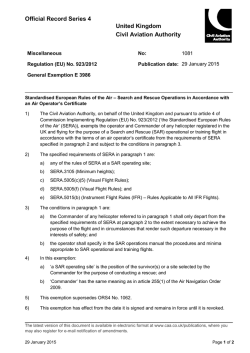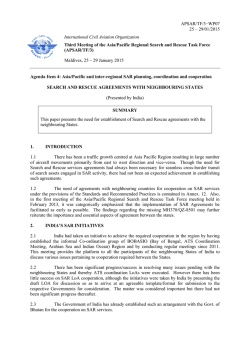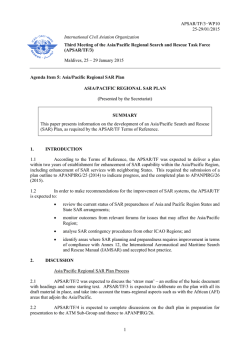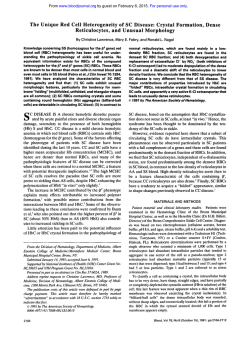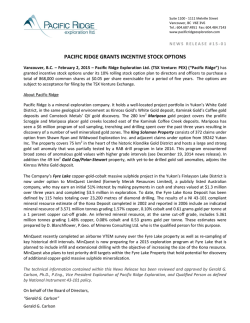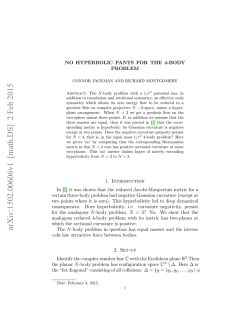
Appendix C ANRF B0-SAR
APSAR/TF/3−Appendix C to the Report 1. AIR NAVIGATION REPORT FORM (ANRF) APAC Regional Planning 2. REGIONAL/NATIONAL PERFORMANCE OBJECTIVE – Module B0-SAR: Improved Safety and Efficiency through the initial application of Regional SAR Initiatives Performance Improvement Area 2: Globally Interoperable Systems and Data Applicable 3. ASBU B0-SAR: Impact on Main Key Performance Areas (KPA) Access & Capacity Efficiency Environment Equity N N Y Y Safety Y 4. ASBU B0-SAR: Planning Targets and Implementation Progress 5. Elements 6. Targets and implementation progress (Ground and Air) November 2018: All States should develop statutes and related provisions for a SAR organization (including National SAR SAR Regulatory and Coordination Committee) and its framework, resources, policies and procedures, Mechanisms including a State SAR Plan, international SAR agreements and SAR exercises (SAREX). November 2018: All States should establish Rescue Coordination Centres (RCCs) of sufficient size with facilities, trained personnel, tools, and access to SAR Units (SRU) commensurate with the State’s responsibilities, or either individually or in cooperation with other SAR Facilities and Resources States (all States should investigate the feasibility of establishing Joint Rescue Coordination Centres (JRCCs) and implement where beneficial). November 2018: All States should establish a centralised SAR information source, which includes data supporting the Aeronautical SAR Information Information Publication (AIP), SAR Library, 24 hour SAR Point of Contacts (SPOC) and Contacts Database of SAR facilities, assets and lists of SRUs. November 2018: All States should implement Quality Assurance (QA) programmes that include continuous improvement and audit SAR Improvement processes, gap and safety/quality indicator analysis, and SAR promotion activities (such as education of users to reduce the incidence of unnecessary SAR responses). Elements 7. ASBU B0-SAR: Implementation Challenges Implementation Area Ground System Avionics Procedures Implementation Implementation Availability Operational Approvals APSAR/TF/3−Appendix C to the Report Elements SAR Regulatory and Coordination Mechanisms SAR Facilities and Resources SAR Information SAR Improvement 7. ASBU B0-SAR: Implementation Challenges Implementation Area Ground System Avionics Procedures Implementation Implementation Availability Legislative restrictions and legal problems enacting SAR agreements. NA NA Lack of political support or awareness (including civil/military cooperation). Lack of local, State Lack of resources to and regional Lack of establish appropriate agreements appropriate facilities and SRUs, communications between agencies including Cospasto facilitate sharing and locationSarsat facilities or of SAR resources, finding sharing access with including SRUs. equipment. other States. Lack of computers and software NA NA NA Lack of established information support processes. Lack of regional and local training of RCC staff and SRU operators. Lack of QA, improvement plans and procedures. Operational Approvals NA Lack of Civil/Military SAR cooperation, including use of military facilities and SRUs. NA NA 8. ASBU B0-SAR: Performance Monitoring and Measurement 8A. ASBU B0-SAR: Implementation Monitoring Elements Performance Indicators/Supporting Metrics Indicators: Percentage of States implementing SAR regulatory and coordination mechanisms in accordance with the Asia/Pacific SAR Plan SAR Regulatory and Coordination Mechanisms Supporting metric: Number of States implementing SAR regulatory and coordination mechanisms in accordance with the Asia/Pacific SAR Plan Indicators: Percentage of States establishing SAR facilities, personnel resources and assets, in accordance with the Asia/Pacific SAR Plan SAR Facilities and Resources Supporting metric: Number of States establishing SAR facilities, resources and assets in accordance with the Asia/Pacific SAR Plan Indicators: Percentage of States implementing SAR information systems in accordance with the Asia/Pacific SAR Plan SAR Information Supporting metric: Number of States implementing SAR information systems in accordance with the Asia/Pacific SAR Plan APSAR/TF/3−Appendix C to the Report 8. ASBU B0-SAR: Performance Monitoring and Measurement 8A. ASBU B0-SAR: Implementation Monitoring Elements Performance Indicators/Supporting Metrics Indicators: Percentage of States implementing SAR improvement programmes in accordance with the Asia/Pacific SAR Plan SAR Improvement Supporting metric: Number of States implementing SAR improvement programmes in accordance with the Asia/Pacific SAR Plan APSAR/TF/3−Appendix C to the Report ASBU B0-SAR: Performance Monitoring and Measurement 8 B. ASBU B0-SAR: Performance Monitoring Key Performance Areas Metrics ( if not indicate qualitative benefits) Access & Equity NA Capacity NA Efficiency Environment Safety Benefit: enhanced sharing of SRUs and information leading to more efficient responses that involve less time searching. Benefit: reduced emissions as a result of reduced fuel burn of airborne, maritime and land based SRUs. Benefit: quicker response times to safety of life events, with better information providing SAR Mission Coordinators the opportunity to better match the SRU with the emergency requirement. Improved civil/military cooperation. ………………………….
© Copyright 2026
